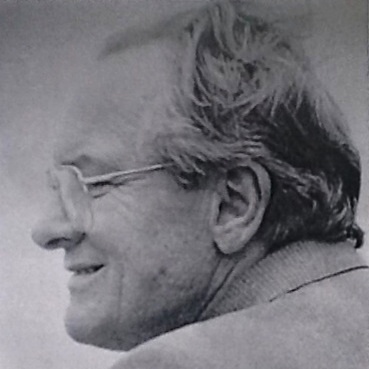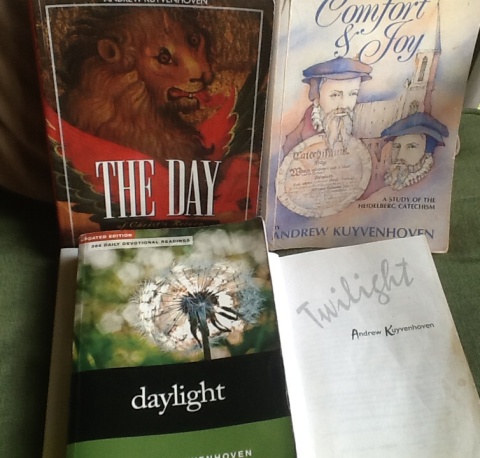
Sense's Reminiscences
by Sense de Jong
gifted Bible interpreter
- Geurt
- Tante Betje (by Sense)
- Tante Betje (by Truus)
- Miss Roozendaal
- Concert in Winschoten
- A baptism remembered
- My birdhouse
- War veterans
- Henk Smit - bass/baritone
- Stefan
- In memory of Herman - I
- In memory of Herman -II
- Remembering AK
- Our love for music
- Herman - Promoter of Christian Causes
- A Salem evening with Herman de Jong
- From Elsinore to Monschau
- A Danish Treat
- Glimpses of Thuringia and Saxony
- Domie and Hansie
- La Manche, Newfoundland
- Bermuda - Isle in the Sun
- 1932 and 1934
- 1940 - 1945
- Winschoten, Grace on the Venne
- 1948
- Johann Sebastian Bach
- From Generation to Generation
- Seven children and a harmonium
- K.P. - A Man of Enterprise
- Cuba and the tragedy of the MS St Louis
- It all began in Norwich, Ontario
Another site by Sense de Jong:
~ Hinne de Jong ~
A Chronicle
Sites by Henry de Jong:
~ Herman de Jong ~
Memorial
~ Newmaker Notes~
Writings, Pictures, Collections
~ AACS/ICS Niagara Conferences~
1970 - 1991
You may be wondering, who is “AK?” Well, anyone familiar with the Christian Reformed Church of North America (CRCNA) will know that AK stands for Andrew Kuyvenhoven, the well-known editor of The Banner from 1980 to 1989. He always ended his editorials with that familiar scrawl, AK. Remember?

Rev. Andrew Kuyvenhoven went to be with his Lord on December 1, 2015. But his legacy continues! Born March 24, 1927 in The Hague, The Netherlands, and educated there, he endured as a teenager the trauma of WWII. He immigrated to Canada in 1952 to marry his beloved Ena (Heerema). He graduated from Calvin Theological Seminary, Grand Rapids, Mich., in 1958.
He subsequently served five CRCs in respectively Lethbridge, Alta., Hamilton, Ont., Wallaceburg, Ont., Oakville, Ont., and Waterdown, Ont. He also served as theological editor for Faith Alive Christian Resources from 1971 to 1976. and then as Editor-in-Chief of The Banner from 1979 to 1989 (succeeding the controversial Dr. Lester De Koster. - sdj)
Somewhere between 1965 and 1975 I personally got to know AK in Grand Rapids, During that time, I had to make frequent trips to Grand Rapids due to the fact that first Classis Alberta North and then Classis Hamilton/Niagara saw fit to appoint me as a delegate to the Board of Publications (or, as we called it, the Board of Pubs). We lived in Edmonton from 1965-1970, prior to moving to St. Catharines, Ont, in 1970.
(Note: In those years CRC had its own plane, flown by Ray Browneye, a dedicated missionary pilot. He made many flights in NA picking up CRC people scheduled to attend board meetings in G.R. and returning them home afterwards (thus saving the CRC a ton of money avoiding all those expensive airline tickets). He prayed a short prayer with his passengers before every take-off. Wonderful man! Before he picked me up, he would first fly to Rochester, N.Y., then fly to the Niagara Airport, close to my home, then onto Toronto and Windsor to pick up more people. Some of those trips were extremely memorable, but that’s another story. – sdj)
AK was the author of several important books, study guides and devotionals. His devotional Daylight , originally printed in 1977, has been through 10 printings and been translated into a number of different languages, blessing thousands by shedding light on what it means “to live in the presence and promises of God.” His obituary adds that this theme was played out beautifully in his own life.
Corrie, my wife, and our four kids, remember how we were blessed by each day’s devotional reading from Daylight and, later, from a follow-up book, called Twilight.
In our home we have a whole set of AK’s books. One is Comfort and Joy, his wonderful study of the Heidelberg Catechism. A most important book is his The Day of Christ’s Return and what follows is what I read on an Amazon page promoting this book on the internet:
“What will Christ’s glorious return to earth be like? How can we get ready for it? Recent years have generated a great deal of talk about a rapture, a great tribulation, an Antichrist, a millennial reign of Christ on earth, a restoration of Israel, and other prophecies. Sorting out fact from fiction, Kuyvenhoven offers a clear, Reformed perspective on issues surrounding the end times – and provides a faith-nurturing journey that helps us live in the faith of our Lord’s return.”
John Bolt, a professor at Calvin Theological Seminary, wrote on the back cover of this book: “As we enter the third millennium and the anxieties of many increase, prophecy will proliferate. Save your money; here’s one guide that stands above the crowd.”
On January 18, 2011 The Banner published one of Rev. Kuyvenhoven’s final articles. It is entitled “Happy Ascension Day!” Yes, he expresses a concern: “Ascension Day…In sharp contrast to Christmas, most churches do not observe it, and the world does not believe it.” Read it for yourself below.
(“Happy Ascension Day,” January 18, Copyright @2011 The Banner, Christian Reformed Church in NA. All rights reserved. Used by permission. // The Banner.org)
HAPPY ASCENSION DAY!
(January 18, 2011/Column Faith Matters/Rev. Andrew Kuyvenhoven)
The church’s calendar not only includes a date to remember the birth of Jesus (Dec. 25), we also have a date to remember his coronation as King Omnipotent,
We call it Ascension Day.
This year (2011) the day falls on May 5. In sharp contrast with Christmas, most churches do not observe it, and the world does not believe it.
It isn’t so terrible to forget liturgical calendar dates. But the facts of Christ’s lordship and the reality of the Holy Spirit’s presence must figure big in our Christian confession and in our every day living. Once I instructed a man who had grown up in Italy. He could think of Jesus only as a bambino whose caregiver was the virgin Mary. It was a big leap for him to go from that view of the infant Jesus to that of the present lordship of our Savior.
What happened at the Ascension? By going from earth to heaven, Jesus went from the place that is governed to the seat of government – God’s right hand. And just as Pharaoh did not do anything in the land of Egypt except through the hand of Joseph, so the sovereign God now deals with his world through Jesus.
Only through Jesus do we have access to God, and only through Jesus God comes to dwell in us. Only by Jesus God rules over us, and by Jesus God will judge this world.
The event of the Ascension is described only by Luke (24:51 and Acts 1:9). If we think of it spatially (“We are now cruising at 30,000 feet…”), we get into trouble. The Bible writers assume a three-story universe – which can bother us folks who live in the “space age.” However, the three-level world (heaven, earth and the pit) is not the point of the Bible’s teaching.
When Paul writes that Jesus “ascended far above all the heavens” (Eph. 4:10, NRSV), he doesn’t want us to understand that spatially (“he went 20,000 feet above the angel gallery”). Instead height conveys the idea of position and power: “God exalted him to the highest place and gave him the name that is above every name” (Phil. 2:9). It describes Jesus’ position and rank in the cosmic hierarchy.
Jesus of Nazareth fulfills the Old Testament expectation of a (Son of) Man whom God has set over “all things” and who rules until all his enemies have surrendered.The theme of the exalted king who, under God, rules in utter freedom (Ps. 8, 110) plays throughout the New Testament with rich variations. The church does not listen enough to that music. Churches make too much of Christmas and too little of the ascension. In that respect we’re out of step with the New Testament.
Jesus reigns! The devil has been kicked out of the driver’s seat. Satan is on a chain, and Jesus is Lord. For Christ “has ascended far above all the heavens, so that he might fill all things.” “All things” means nothing is excluded, Jesus says, “All authority in heaven and on earth has been given to me” (Matt. 28:18) – nothing falls outside of his dominion.
Our job is to acknowledge and proclaim Jesus as Savior and Lord. We must do so extensively (“make disciples of all nations,” Matt. 28:19). And we must do so intensively because he is Savior and Lord of head and hand, house and hearth, money and business, dating and mating. All human activity must be performed under Christ’s redeeming reign.
Either Jesus is Lord of all, or he’s not Lord at all.
AK
[an error occurred while processing this directive]
